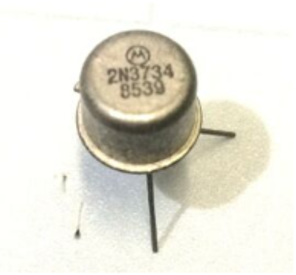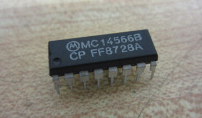 75 years ago on December 16, 1947, Walter Brattain and John Bardeen managed to build and test the first working transistor. The point-contact transistor was made of two gold foil contacts sitting on a germanium crystal. As a “magnificent Christmas present" William Shockley, John Bardeen, and Walter Brattain later demonstrated the point-contact transistor on December 23, 1947 to executives at Bell Laboratories. The New York Herald Tribune predicted that this invention would be a revolution in the electronics industry. Little did they know just how big of a technology revolution this invention would end up being. The invention of the transistor may have been the greatest technology development of the 20th century!
75 years ago on December 16, 1947, Walter Brattain and John Bardeen managed to build and test the first working transistor. The point-contact transistor was made of two gold foil contacts sitting on a germanium crystal. As a “magnificent Christmas present" William Shockley, John Bardeen, and Walter Brattain later demonstrated the point-contact transistor on December 23, 1947 to executives at Bell Laboratories. The New York Herald Tribune predicted that this invention would be a revolution in the electronics industry. Little did they know just how big of a technology revolution this invention would end up being. The invention of the transistor may have been the greatest technology development of the 20th century!
 As the performance, reliability, and manufacturability of discrete transistors improved commercial products began to use transistors, including amplifiers, switches, and detector circuits. In 1954 the silicon bipolar-junction transistor (BJT), perfected by Gordon Teal of Texas Instruments Inc., brought the price of this discrete component down to $2.50. The Texas Instruments news release from May 10, 1954, read, "Electronic "brains" approaching the human brain in scope and reliability came much closer to reality today with the announcement by Texas Instruments Incorporated of the first commercial production of silicon transistors kernel-sized substitutes for vacuum tubes." Also in 1954 Bell Labs unveiled Tradic Phase One. The Tradic Phase One was the world’s first fully transistorized computer containing 800 transistors instead of vacuum tubes. In March 1955 Sony began to sell its TR-52 transistor radio in the US for $29.95, soon capturing this market. It is no wonder that in 1956 John Bardeen, Walter Brattain and William Shockley received the Nobel Prize in Physics.
As the performance, reliability, and manufacturability of discrete transistors improved commercial products began to use transistors, including amplifiers, switches, and detector circuits. In 1954 the silicon bipolar-junction transistor (BJT), perfected by Gordon Teal of Texas Instruments Inc., brought the price of this discrete component down to $2.50. The Texas Instruments news release from May 10, 1954, read, "Electronic "brains" approaching the human brain in scope and reliability came much closer to reality today with the announcement by Texas Instruments Incorporated of the first commercial production of silicon transistors kernel-sized substitutes for vacuum tubes." Also in 1954 Bell Labs unveiled Tradic Phase One. The Tradic Phase One was the world’s first fully transistorized computer containing 800 transistors instead of vacuum tubes. In March 1955 Sony began to sell its TR-52 transistor radio in the US for $29.95, soon capturing this market. It is no wonder that in 1956 John Bardeen, Walter Brattain and William Shockley received the Nobel Prize in Physics.
 Thanks to Jack Kilby at Texas Instruments and Robert Noyce at Fairchild Semiconductor, the 1960’s ushered in the era of Integrated Circuits (ICs). In the early 70’s the crowning achievement was the ability to integrate thousands of transistors and resistors onto a silicon chip. One of the most important ICs was the microprocessor. Intel's 4004 microprocessor is widely regarded as the first commercial microprocessor. The 4004 was fabricated in 1971 with 2,250 Metal Oxide Semiconductor (MOS) transistors using 10 µm PMOS technology. PMOS logic is a family of digital circuits based on p-channel metal–oxide–semiconductor field-effect transistors (MOSFETs). In the late 1960s and early 1970s. In the mid-70’s PMOS circuits were superseded by Complimentary Metal–Oxide–Semiconductor (CMOS) circuits. CMOS circuits use both p-channel and n-channel transistors. Today Apple’s M1 chip has 16 billion transistors using TSMC’s 5 nm FINFET CMOS technology node!
Thanks to Jack Kilby at Texas Instruments and Robert Noyce at Fairchild Semiconductor, the 1960’s ushered in the era of Integrated Circuits (ICs). In the early 70’s the crowning achievement was the ability to integrate thousands of transistors and resistors onto a silicon chip. One of the most important ICs was the microprocessor. Intel's 4004 microprocessor is widely regarded as the first commercial microprocessor. The 4004 was fabricated in 1971 with 2,250 Metal Oxide Semiconductor (MOS) transistors using 10 µm PMOS technology. PMOS logic is a family of digital circuits based on p-channel metal–oxide–semiconductor field-effect transistors (MOSFETs). In the late 1960s and early 1970s. In the mid-70’s PMOS circuits were superseded by Complimentary Metal–Oxide–Semiconductor (CMOS) circuits. CMOS circuits use both p-channel and n-channel transistors. Today Apple’s M1 chip has 16 billion transistors using TSMC’s 5 nm FINFET CMOS technology node!
Authors: Kevin Hilgers and Kevin Nordquist

